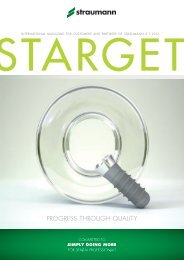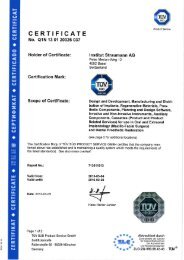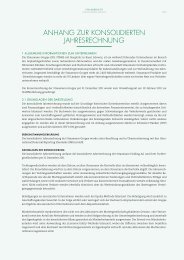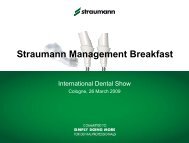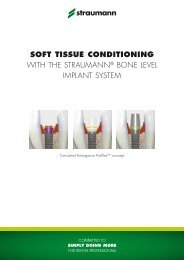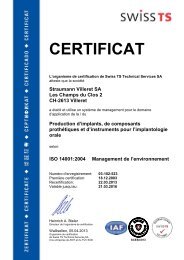Straumann launches Roxolidâ¢, a new high performance material ...
Straumann launches Roxolidâ¢, a new high performance material ...
Straumann launches Roxolidâ¢, a new high performance material ...
You also want an ePaper? Increase the reach of your titles
YUMPU automatically turns print PDFs into web optimized ePapers that Google loves.
Media Release<br />
<strong>Straumann</strong> <strong>launches</strong> Roxolid, a <strong>new</strong> <strong>high</strong> <strong>performance</strong><br />
<strong>material</strong> for dental implants<br />
New <strong>material</strong> increases the choice of treatment options with small diameter<br />
implants<br />
Roxolid combines <strong>high</strong>er tensile and fatigue strengths 1 with excellent<br />
osseointegration 2 and is designed to increase reliability and confidence with<br />
small diameter implants<br />
Less invasive treatment using smaller implants is expected to increase<br />
patient acceptance of implant solutions<br />
More than 6300 Roxolid implants in controlled release program and<br />
international clinical trials<br />
Roxolid Ø3.3mm Bone and Tissue Level implants are now available in the<br />
US and Canada; European launch to follow in the coming weeks<br />
Allograft bone augmentation <strong>material</strong> launched in US; FDA approves<br />
<strong>Straumann</strong> ® Emdogain for combined use with various bone graft <strong>material</strong>s 15<br />
Basel/Boston 14 September 2009: At the 2009 Annual Meeting of the American<br />
Academy of Periodontology (AAP) currently taking place in Boston, <strong>Straumann</strong><br />
announced the full market launch in North America of its <strong>new</strong> <strong>high</strong> <strong>performance</strong> dental<br />
implant <strong>material</strong> Roxolid. <strong>Straumann</strong> Ø3.3mm Bone and Tissue Level implants are<br />
now available in the <strong>new</strong> <strong>material</strong> in the US and Canada, offering customers a <strong>new</strong><br />
level of confidence with small diameter implants. Ø3.3mm implants currently generate<br />
approximately 15% of the company’s global implant sales.<br />
Higher tensile and fatigue strengths combined with the excellent<br />
osseointegration of SLActive<br />
Roxolid is an alloy of titanium and zirconium and has been designed specifically for<br />
dental implants. Its name conveys the concept of natural physical strength combined<br />
with solidity (osseointegration).<br />
Rigorous tests in <strong>Straumann</strong> laboratories have shown that the <strong>new</strong> <strong>material</strong> has <strong>high</strong>er<br />
fatigue and tensile strength than pure titanium (grade 4 annealed and cold worked), the<br />
current <strong>material</strong> of choice for dental implants. In addition, preclinical study results have<br />
indicated that bone integrated with Roxolid better than with pure titanium (grade 4) 3 .<br />
The combination of enhanced strength and osseointegration opens the door for a <strong>new</strong><br />
generation of small diameter implants, which may be particularly advantageous in<br />
situations where there is limited space between teeth, and when preserving existing<br />
bone and vascular supply is important. A further potential advantage could be the use<br />
in thin alveolar bone.<br />
1 / 5
<strong>Straumann</strong>’s largest prelaunch clinical program to date<br />
Engineered and developed by <strong>Straumann</strong>, Roxolid has been undergoing a broad<br />
program of clinical trials in 9 countries, the first of which began almost 2 years ago.<br />
Involving 60 centers and more than 300 patients, this is one of the largest clinical<br />
research programs ever undertaken by a dental implant company prior to market<br />
launch. Based on reports to date, the implant survival rate exceeds 99%. In addition,<br />
Roxolid has been made available to 450 selected specialists in a controlled release<br />
program, in which more than 6300 implants have now been distributed.<br />
Initial clinical reports have already been presented by lead investigators at recent major<br />
congresses 4,5,6,7 , including a review of the scientific evidence and clinical application by<br />
Professor Hans-Peter Weber (Chair of the Department of Restorative Dentistry and<br />
Bio<strong>material</strong>s Sciences at Harvard School of Dental Medicine) at the AAP, currently<br />
taking place in Boston.<br />
Although <strong>Straumann</strong> obtained regulatory clearance several months ago, the company<br />
chose not to launch Roxolid until the available data from preclinical and clinical trials,<br />
including 12-month results from completed studies, had been reviewed by a Clinical<br />
Advisory Board of independent experts. On the basis of their unanimous<br />
recommendation, <strong>Straumann</strong> is proceeding with a full market launch, beginning in<br />
North America, the world’s largest market for dental implants. Roxolid will also become<br />
available to doctors and patients in Europe in the coming weeks.<br />
The need for <strong>high</strong> <strong>performance</strong> <strong>material</strong>s<br />
Pure titanium is well known for its biological compatibility with the human body and its<br />
resistance to corrosion. The discovery that bone integrates with titanium<br />
(osseointegration) opened the way for its use in orthopedic surgery and subsequently<br />
in implant dentistry, where its physical properties were also important in order to bear<br />
the very strong forces of chewing. However, the mechanical properties are limited in<br />
the case of small diameter implants or parts, which are needed for narrow spaces. This<br />
prompted the use of alternative <strong>material</strong>s, such as titanium alloys (e.g. Ti-6Al-4V,<br />
‘TAV’), but additional strength came at the price of impaired osseointegration due to<br />
inferior biocompatibility and surface characteristics 8,9,10,11 .<br />
According to published research 4 , titanium and zirconium are the only two metals<br />
commonly used in implantology that do not inhibit the growth of osteoblasts, the bone<br />
forming cells that are essential for osseointegration. In contrast, the alloy of titanium<br />
and vanadium (TAV) has been shown to compromise osseointegration 10,11 .<br />
Furthermore, TAV cannot accommodate the sophisticated microstructuring processes<br />
required for <strong>Straumann</strong>’s third generation SLActive ® surface technology, which<br />
enhances osseointegration.<br />
Excellent osseointegration with the SLActive surface<br />
Surface texture, purity and hydrophilicity are important contributors to optimal<br />
osseointegration and successful implant outcomes. In 2005, <strong>Straumann</strong> introduced its<br />
third generation implant surface technology SLActive, which cut implant<br />
osseointegration times in half to 3-4 weeks from 6-8 weeks, which was the benchmark<br />
established by SLA ®12 . Since its launch, more than a million SLActive implants have<br />
been sold and it has set a benchmark for enhanced osseointegration.<br />
2 / 5
Initial results from large clinical program<br />
In a prospective pilot clinical trial, which is still ongoing, Ø3.3mm Roxolid implants were<br />
placed in 22 patients. One-year data were presented at the Europerio Congress in<br />
Stockholm, including bone level measurements, which showed bone gain in 50% of the<br />
patients 13 .<br />
A multicenter double-blind randomized study also is underway in 8 European centers<br />
with more than 90 patients. The one-year follow-up data, which are currently being<br />
evaluated, will be presented at forthcoming scientific meetings.<br />
A non-interventional clinical study is also underway with more than 400 implants placed<br />
in 230 patients in Europe and North America. More than 50% of the patients in this<br />
study have been followed for 6 months or more.<br />
The potential of smaller implants<br />
In the future, <strong>high</strong> strength, small diameter implants with enhanced osseointegration<br />
properties are expected to offer a number of advantages to dental professionals and<br />
patients, including: enhanced esthetics, broader treatment options, shorter treatment<br />
times and reduced costs. This is important as patients often fear implant treatment<br />
because of the associated pain, time, and cost. <strong>Straumann</strong> believes that Roxolid will<br />
therefore increase the general acceptance of implant dentistry and will contribute to<br />
further enhancing confidence among practitioners placing implants.<br />
Additions to regenerative portfolio<br />
The company also used the AAP as a platform for the US introduction of <strong>Straumann</strong> ®<br />
Allograft, the oral bone augmentation <strong>material</strong> supplied through <strong>Straumann</strong>’s<br />
partnership with LifeNet Health ® . The latter is the world’s largest provider of bioimplants<br />
and organs for transplantation and the longest accredited tissue banking<br />
organization in the world.<br />
Allograft <strong>material</strong>s make up more than 50% of the dental bone augmentation market in<br />
the US, which was estimated to be worth USD 97 million in 2008 14 . <strong>Straumann</strong> Allograft<br />
complements the company’s fully synthetic BoneCeramic, which was launched in the<br />
US in 2005.<br />
Additionally, <strong>Straumann</strong> announced that it has received FDA approval for a <strong>new</strong><br />
indication of Emdogain, the company’s flagship regenerative product. Emdogain can<br />
now be used in the US with a number of bone graft <strong>material</strong>s 15 , in wide defects where<br />
additional soft tissue support is needed.<br />
With these <strong>new</strong> offerings, <strong>Straumann</strong> continues its commitment to providing dental<br />
professionals in the US with a range of treatment options as part of a comprehensive<br />
portfolio of products for restorative, replacement and regenerative dentistry.<br />
About <strong>Straumann</strong><br />
Headquartered in Basel, Switzerland, the <strong>Straumann</strong> Group (SIX: STMN) is a global<br />
leader in implant and restorative dentistry and oral tissue regeneration. In collaboration<br />
with leading clinics, research institutes and universities, <strong>Straumann</strong> researches,<br />
develops and manufactures dental implants, instruments, prosthetics and tissue<br />
regeneration products for use in tooth replacement and restoration solutions or to<br />
3 / 5
prevent tooth loss. <strong>Straumann</strong> currently employs approximately 2200 people worldwide<br />
and its products and services are available in more than 70 countries through its broad<br />
network of distribution subsidiaries and partners.<br />
<strong>Straumann</strong> Holding AG, Peter Merian-Weg 12, 4002 Basel, Switzerland.<br />
Phone: +41 (0)61 965 11 11 / Fax: +41 (0)61 965 11 01<br />
E-mail: investor.relations@straumann.com or corporate.communication@straumann.com<br />
Homepage: www.straumann.com<br />
Contact:<br />
Mark Hill, Corporate Communication<br />
Fabian Hildbrand, Investor Relations<br />
+41 (0)61 965 13 21 +41 (0)61 965 13 27<br />
Disclaimer<br />
This release contains certain “forward-looking statements”, which can be identified by the use of<br />
terminology such as “to follow”, “will”, “potential”, “would”, “may”, “should”, “confidence”, “future”,<br />
“expected”, “believes”, “increase”, “enhance”, or similar wording. Such forward-looking statements reflect<br />
the current views of management and are subject to known and unknown risks, uncertainties and other<br />
factors that may cause actual results, <strong>performance</strong> or achievements of the Group to differ <strong>material</strong>ly from<br />
those expressed or implied. These include risks related to the success of and demand for the Group’s<br />
products, the potential for the Group’s products to become obsolete, the Group’s ability to defend its<br />
intellectual property, the Group’s ability to develop and commercialize <strong>new</strong> products in a timely manner,<br />
the dynamic and competitive environment in which the Group operates, the regulatory environment,<br />
changes in currency exchange rates, the Group’s ability to generate revenues and profitability, and the<br />
Group’s ability to realize its expansion projects in a timely manner. Should one or more of these risks or<br />
uncertainties <strong>material</strong>ize, or should underlying assumptions prove incorrect, actual results may vary<br />
<strong>material</strong>ly from those described in this release. <strong>Straumann</strong> is providing the information in this release as of<br />
this date and does not undertake any obligation to update any forward-looking statements contained in it<br />
as a result of <strong>new</strong> information, future events or otherwise.<br />
Photographs and further information<br />
Photographs for journalistic use and further information are available on request from<br />
<strong>Straumann</strong> Corporate Communication.<br />
1 Compared with grade 4 annealed and cold worked titanium; data on file, comparing <strong>material</strong> with<br />
specifications from standard ASTM F67<br />
2 Thoma D et al. ‘Evaluation of a <strong>new</strong> titanium-zirconium dental implant. A comparative radiographic study<br />
in the canine mandible‘ Oral presentation at the 24th Annual meeting of the Academy of<br />
Osseointegration (AO), San Diego<br />
3 Gottlow J et al. Preclinical data presented at the 23rd Annual meeting of the Academy of<br />
Osseointegration (AO), Boston, February 2008, and at the 17th Annual Scientific Meeting of the<br />
European Association for Osseointegration (EAO), Warsaw, September 2008<br />
4 Stone P. Experience <strong>new</strong> confidence and freedom with small diameter implants. European Federation of<br />
Periodontology 6th Congress, Stockholm, Sweden, 4-6 June 2009.<br />
5 Thoma DS. Evaluation of a <strong>new</strong> titanium-zirconium dental implant. A comparative radiographic study in<br />
the canine mandible. Academy of Osseointegration 24th Annual Meeting, San Diego, CA, USA, 26-28<br />
February 2009; Abs. SO4.<br />
6 Gottlow J. Make a difference with the next generation implant properties. European Association for<br />
Osseointegration 17th Annual Scientific Meeting, Warsaw, Poland, 18-20 September 2008.<br />
7 Barter S. New reduced diameter implants for wider clinical options. European Association for<br />
Osseointegration 17th Annual Scientific Meeting, Warsaw, Poland, 18-20 September 2008.<br />
8 Steinemann S. Peridontol 2000 1998;17:7-21<br />
9 Wong M et al. J. Biomed Mater Res 1995;29:1567-1575<br />
10 Stenport VF, Johansson CB. Clin Implant Dent Relat Res. 2008, 10:191-9<br />
11 Johansson CB et al. Int J Oral Maxillofac Implants 1998;13:315–321<br />
4 / 5
12 Oates TW et al. Int J Oral Maxillofac Implants 2007;22:755-760<br />
13 Stone P. Clinical data presented at the EuroPerio 2009, Stockholm, June 2009<br />
14 Millennium Research<br />
15 Autograft, allograft, bone derived xenograft, B-tricalcium phosphate, and bioactive glass<br />
5 / 5




